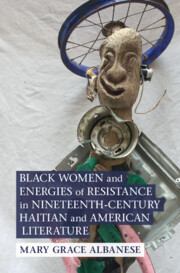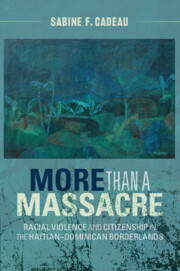108 results
COVID-19 knowledge and mental health impact assessment in Haiti
-
- Journal:
- Cambridge Prisms: Global Mental Health / Volume 11 / 2024
- Published online by Cambridge University Press:
- 29 January 2024, e19
-
- Article
-
- You have access
- Open access
- HTML
- Export citation
Chapter 1 - Powering the Soul
-
- Book:
- Black Women and Energies of Resistance in Nineteenth-Century Haitian and American Literature
- Published online:
- 09 November 2023
- Print publication:
- 23 November 2023, pp 16-36
-
- Chapter
- Export citation
Introduction
-
- Book:
- Black Women and Energies of Resistance in Nineteenth-Century Haitian and American Literature
- Published online:
- 09 November 2023
- Print publication:
- 23 November 2023, pp 1-15
-
- Chapter
- Export citation
Chapter 16 - Decolonizing the Bible as Literature
- from Part III - Interdisciplinarity and Literary Studies
-
-
- Book:
- Decolonizing the English Literary Curriculum
- Published online:
- 02 November 2023
- Print publication:
- 09 November 2023, pp 315-330
-
- Chapter
-
- You have access
- Open access
- HTML
- Export citation
15 - Revolution in England? Abolitionism
- from Part II - Western, Central, and Eastern Europe
-
-
- Book:
- The Cambridge History of the Age of Atlantic Revolutions
- Published online:
- 18 October 2023
- Print publication:
- 09 November 2023, pp 396-420
-
- Chapter
- Export citation

Black Women and Energies of Resistance in Nineteenth-Century Haitian and American Literature
-
- Published online:
- 09 November 2023
- Print publication:
- 23 November 2023
22 - Overview of the Haitian Revolution
- from Part III - Haiti
-
-
- Book:
- The Cambridge History of the Age of Atlantic Revolutions
- Published online:
- 18 October 2023
- Print publication:
- 09 November 2023, pp 563-587
-
- Chapter
- Export citation
26 - Establishing a New Nation: Haiti after Independence, 1804–1843
- from Part III - Haiti
-
-
- Book:
- The Cambridge History of the Age of Atlantic Revolutions
- Published online:
- 18 October 2023
- Print publication:
- 09 November 2023, pp 663-688
-
- Chapter
- Export citation
8 - Caribbean South America: Free People of Color, Republican Experiments, Military Strategies, and the Caribbean Connection on the Path to Independence
- from Part I - The Spanish Empire
-
-
- Book:
- The Cambridge History of the Age of Atlantic Revolutions
- Published online:
- 20 October 2023
- Print publication:
- 09 November 2023, pp 228-251
-
- Chapter
- Export citation
5 - Haiti Indemnity and Sovereign Debt
-
- Book:
- When Nations Can't Default
- Published online:
- 19 October 2023
- Print publication:
- 02 November 2023, pp 100-103
-
- Chapter
- Export citation
Chapter 3 - The Language of Lakay
- from Part I - Origins Revisited
-
-
- Book:
- Diaspora and Literary Studies
- Published online:
- 20 July 2023
- Print publication:
- 10 August 2023, pp 64-77
-
- Chapter
- Export citation
12 - IOM’s Engagement with the UN Guiding Principles on Internal Displacement
- from Part II - IOM in Action
-
-
- Book:
- IOM Unbound?
- Published online:
- 15 June 2023
- Print publication:
- 29 June 2023, pp 326-359
-
- Chapter
-
- You have access
- Open access
- HTML
- Export citation
10 - African American Cultural Diversity
- from Part III - African American Income and Wealth, 1965–Present
-
- Book:
- The Economics of Structural Racism
- Published online:
- 06 April 2023
- Print publication:
- 13 April 2023, pp 258-282
-
- Chapter
- Export citation
3 - Small Wars and Guerrilla Fighting
- from Part I - The Nature of Warfare in the Napoleonic Era
-
-
- Book:
- The Cambridge History of the Napoleonic Wars
- Published online:
- 20 December 2022
- Print publication:
- 02 March 2023, pp 47-64
-
- Chapter
- Export citation
28 - Haiti, Slavery and the War in the Caribbean
- from Part V - Other Spheres of War
-
-
- Book:
- The Cambridge History of the Napoleonic Wars
- Published online:
- 20 December 2022
- Print publication:
- 02 March 2023, pp 586-606
-
- Chapter
- Export citation
Why Rara Burns Judas during Lent: Rethinking the Origins of Catholic Elements in Haitian Culture from an Afro-Iberian Perspective
-
- Journal:
- The Americas / Volume 80 / Issue 1 / January 2023
- Published online by Cambridge University Press:
- 10 February 2023, pp. 33-68
- Print publication:
- January 2023
-
- Article
-
- You have access
- Open access
- HTML
- Export citation
Chapter 7 - Diaspora and Black Internationalism
-
- Book:
- Voices of the Race
- Published online:
- 25 August 2022
- Print publication:
- 01 September 2022, pp 255-296
-
- Chapter
- Export citation
8 - Competition, Conflict, and Cooperation
-
-
- Book:
- The Cambridge Companion to Caribbean Music
- Published online:
- 17 September 2022
- Print publication:
- 04 August 2022, pp 110-123
-
- Chapter
- Export citation

More than a Massacre
- Racial Violence and Citizenship in the Haitian–Dominican Borderlands
-
- Published online:
- 02 June 2022
- Print publication:
- 09 June 2022
8 - Exceptionalism in Practice?
-
- Book:
- Cuban Privilege
- Published online:
- 19 May 2022
- Print publication:
- 02 June 2022, pp 317-342
-
- Chapter
- Export citation



